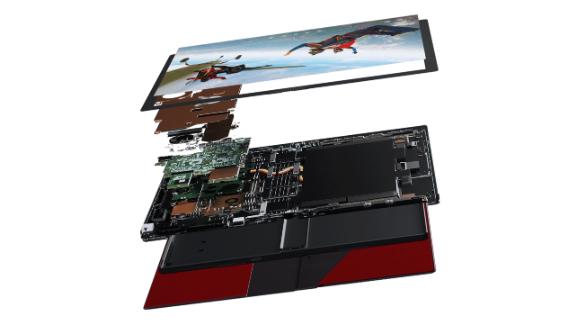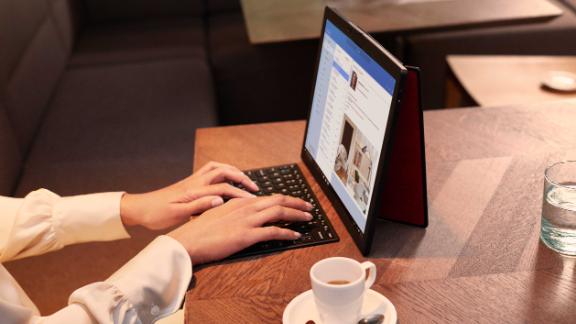Years before we even heard whispers of a Galaxy Fold or a Z Flip, Lenovo and Intel had an idea. And one day, they put their minds together, along with their respective teams, to flush it out. What started out as an idea built out of pieces of cardboard morphed into, what they hope, is a revolutionary device: the world’s first foldable PC.
Tech enthused as we are, the possibility of a foldable PC you can pack up and tote around had us excited, to say the least. When Lenovo and Intel debuted the concept at the 2020 Consumer Electronics Show, we were no longer simply excited — we were impressed. Now, in an exclusive interview with CNN Underscored, Jerry Paradise, vice president of global commercial portfolio and product management at Lenovo, and Josh Newman, vice president of client computing group and general manager of mobile innovation at Intel, walk us through how the ThinkPad X1 Fold came to fruition.
The process — from ideation to cardboard mockups to hitting the market — has lasted four years, at least. And that’s a long time for a product, especially in the age of tech buzzwords. In that time, the mobile world has seen an equal share of excitement and disappointment when it comes to foldable devices. Now there’s the Galaxy Z Fold 2 (a standard phone that folds into a tablet), the Surface Duo (which pairs two screens together like two monitors) and the Z Flip (which goes from compact to full smartphone).
The ThinkPad X1 Fold — up for preorder starting September 29 for $2,499 — pushes past these with a punch into hyperdrive. Unfold it and use it as a tablet. Stand it up for a desktop experience. And even fold it in half to a right angle, lay the magnetic keyboard down and use it as a mini clamshell. “It’s how it transforms throughout the day, from a full tablet mode … to a clamshell and [the ability to] use it as a productivity device and transforming it into full productivity mode with it on my desk,” says Paradise.

The X1 Fold moves PC design forward and required a full two teams to make it happen. The Lenovo and Intel teams spent a lot of time together and went from “a few rough sketches on paper and a dream in somebody’s head” into concept devices, notes Paradise. At first, it was just cardboard cutouts. During the process, the team developed more than six different hinges, along with more than 20 variants of those. That’s because, as we’ve noted with foldable devices in the past, the hinge functionality is crucial. Ultimately, for the X1 Fold, the team settled on a multilink hinge that actually adds tension to the display when it’s fully unfolded. And it’s not the top polymer OLED layer of the screen stretching. Instead, it’s a five-layer display (the final being silicone) and carbon fiber panels beneath it. The result is a screen that feels rigid and has a backbone to absorb presses, taps and potential scratches. This display and the hinge work in tandem to deliver a seamless experience.

When we first got our hands on the X1 Fold back at the 2019 Consumer Electronics Show, the hinge operated smoothly with folding and unfolding. The display didn’t feel nearly as delicate as the first-generation Galaxy, nor did it come with the same warnings of how to use the display. The carbon fiber layer under the display was evident. That display wasn’t an easy feat, either, with Newman explaining the “plastic OLED obviously delivers stunning color [and is] very thin, but it also has challenges. … How do you keep the display very flat so that you have a great experience?”
Another huge challenge to creating a foldable PC: condensing the parts down. Think about Steve Jobs and the team at Apple figuring out how to get a massive vinyl collection into a tiny iPod. Sounds impossible at first thought, but Paradise and Newman were up to the challenge. “We had to solve lots of problems with board size and power and thermal. And, of course, a brand-new OLED foldable panel. It was just a different kind of laptop,” says Newman.
A traditional laptop has a lot of space — mainly found directly under the keyboard. That’s where the motherboard, processor, GPU, ports, storage and battery cells all have to fit. The X1 Fold effectively cuts that in half.

The big difference with the X1 Fold is how the processor sits. Traditionally, it’s a long piece of parts that gets soldered into a laptop, but with Lakefield (the code name for Intel’s Hybrid processors), Intel stacks the pieces to keep it super thin. “It’s a 12-by-12-by-1-millimeter package for the processor itself, and it’s a Foveros packaging technology,” says Newman. “We actually are stacking — so we have a compute layer, a memory layer, an I/O layer — so we can build up. That makes the package really small and the whole motherboard can shrink around it.” All of this fits inside the 11-millimeter thickness of this folding PC.
Since this device is within the ThinkPad family, it also had to meet durability needs as well as specific tests for a foldable. That means MilSpec out of the box (a set of standards for testing durability, ruggedness and reliability) and the traditional 200 torture tests that Lenovo puts ThinkPads through — tests like intense vibrations, high-altitude usage, extreme hot and cold temperatures and a number of drop tests. Lenovo paid close attention to the screen on the X1 Fold, though. “The carbon fiber plates that are sitting behind the display [are there to] absorb shock from behind the display,” Paradise says.
As with any foldable, various things will undoubtedly touch the display and potentially get sandwiched when it’s folded. The X1 Fold needs to stand up to paper clips, pens and other items getting stuck in between both displays. You don’t want them to crunch and cause irreversible damage to the display. When closed, with nothing in between, there is a small gap between the two halves. For now, this is the nature of folding devices.
But an optional accessory, which seems really necessary for getting the most out of the X1 Fold, can fill in that gap: the $299 Lenovo Fold Mini Keyboard. It just attaches to either side of the X1 Fold screen with magnets. You can leave it on 24/7 if you choose and, when you fold up the X1 Fold, it fills in that gap. Better yet, when on the display, it will also wirelessly charge through induction. It pairs to the X1 fold via Bluetooth, and positioning it on the left side and folding the right side gives you a clamshell-like experience. It even reminds us a bit of a netbook. And for ThinkPad fans, there’s no red dot for a mouse on this keyboard. It makes sense, though, as this is a fully touch-first device.

Something that was nonnegotiable from the start: Windows 10 on board. The Intel and Lenovo teams knew potential customers count on Windows and the app compatibility to get work done. Aiding in that experience is the Fold Mini Keyboard, which can make you feel more at home. “It has to be a ThinkPad first and foremost; it’s true if you put a keyboard on it, it can’t compromise as a PC. Application compatibility, what people expect from Windows all has to be there,” says Newman. “It had to be Windows 10 Pro; it had to have the full compatibility and capability of the PC. That way they don’t have to compromise — whatever you need to do within your enterprise you’re not going to be limited by having to figure out how to get those things to work. Not limited in the flexibility of what you can do with it, anyway.”
“The field [of potential customers] is going to be pretty broad,” adds Paradise. “We know all the early adopters are all over this. It hits a good tone with professionals, people that are going from consuming content to creating content. We see professionals latching on to this. It’s gonna resonate with early adopters, professional executives — probably first. But we expect, given the fact that it’s so versatile, that it will have broader appeal beyond those users as well.”
In other words, Lenovo and Intel are gearing this up for professionals and those with similar workloads. Though small, the X1 Fold still packs a PC-level punch. It’s powered by an Intel Hybrid processor, which the team paired with 8GB of RAM. The team also opted not to include a dedicated graphics processing unit, instead going for integrated Intel UHD Gen11 Graphics. That will be plenty of power for most productivity tasks: word processing, email, web browsing, enterprise apps, slide decks and crunching numbers in spreadsheets. But, considering it’s just integrated graphics, we wouldn’t call this a gaming PC.
Three ports — two USB-C ports and a SIM card slot — are built in. You can plug in a dongle to add in legacy ports. Included is a 65-watt power adapter that you’ll use to charge from either of the USB-C ports. Inside the ThinkPad X1 fold is a 50-watt-hour battery that’s split between the left and right sides.
Arguably, a bit more interesting is that SIM card slot, since the X1 Fold has 5G Sub6 and 4G LTE antennas inside. This means, with service, you can really use the X1 Fold anywhere. We’re also pretty impressed to see room for 5G in generation one of the X1 Fold. And if you want to take video calls on the fly, there’s a 5-megapixel HD camera that’ll work just fine.

The processor is a slimmer and more compact Intel Core Processor with Intel Hybrid Technology, but it can still scale up while being efficient. “The biggest thing is the hardware guided scheduling in the processor, [which] is really just constantly looking at the most power-efficient way to run whatever workloads are there,” says Newman. “The Hybrid Technology allows us to operate in a much lower power range than a core processor in traditional notebook design. It’s a Sunny Cove core for incredibe single-threaded performance and four lower-power Tremont cores — lower power but fully compatible Intel architecture,” Newman says. This Hybrid processor setup allows for the X1 Fold to decide which hardware it taps into for the best experience with whatever you’re trying to accomplish. This way the PC can amp up to handle a massive spreadsheet and pull it back for a simple Netflix stream.
As a whole, we think Lenovo is on to something here. Partnering with Intel allowed two teams with a rich history to really put their minds together and deliver the world’s first foldable PC. That’s an accomplishment in its own right, but we imagine that what was learned here will touch countless other devices.
And it’s not one that Lenovo will be leaving unwatched. “We have started many categories in our history; we’ll be committed to this space as well,” says Paradise.
“Continuing to try new categories and try new ways of bringing experiences together is going to be crucial for Lenovo to continue this kind of work so we can enrich more people’s lives in more ways,” Newman adds.
The Link LonkSeptember 29, 2020 at 05:07PM
https://ift.tt/345oyyI
How the world's first foldable PC came to be - CNN
https://ift.tt/2YXg8Ic
Intel

No comments:
Post a Comment